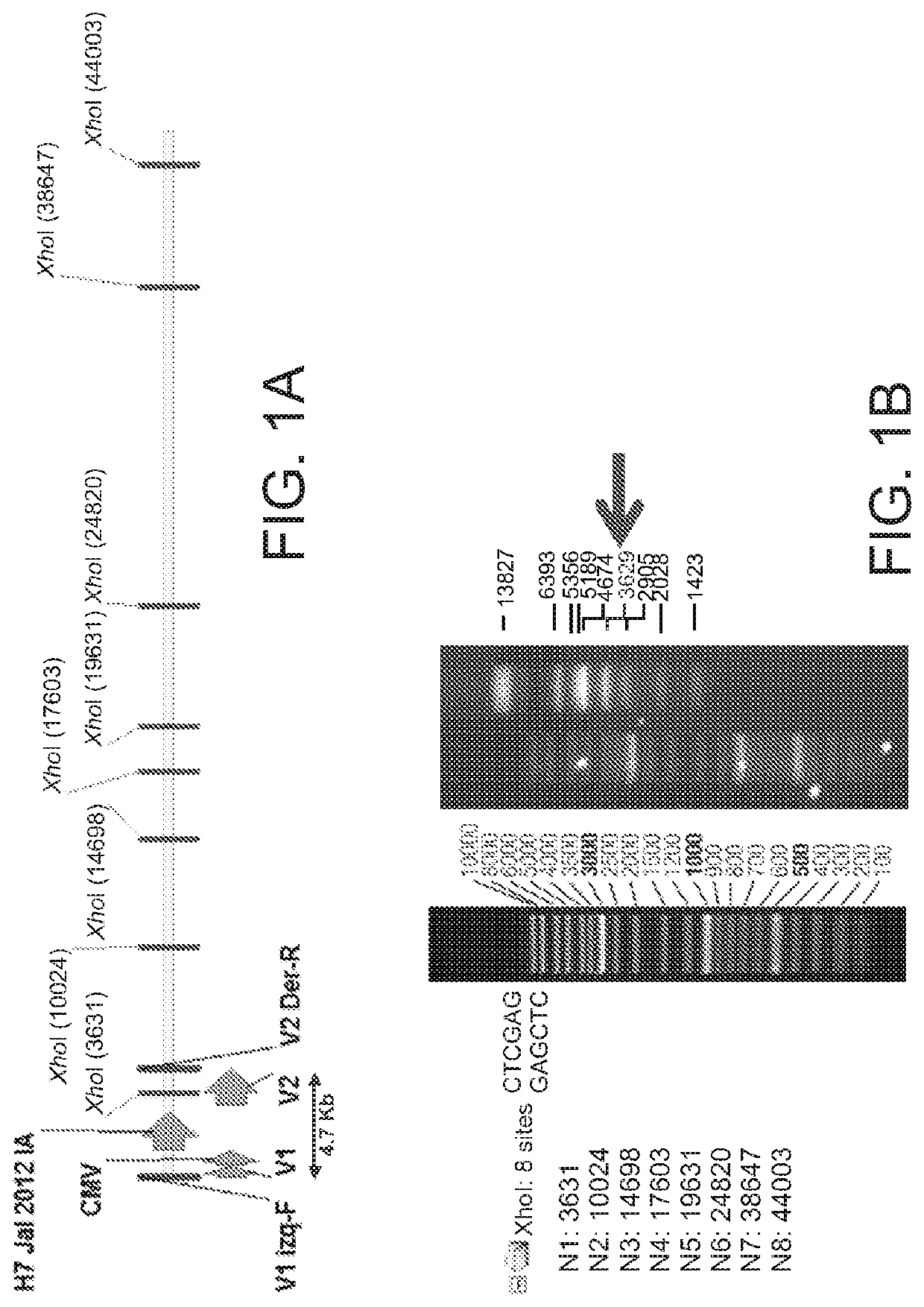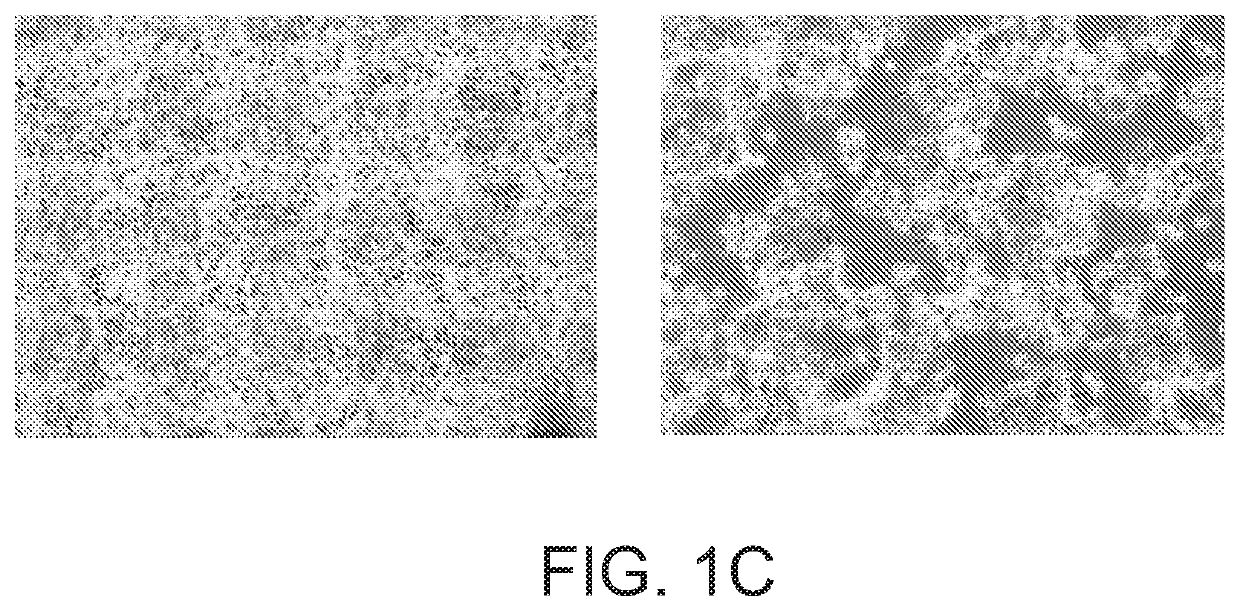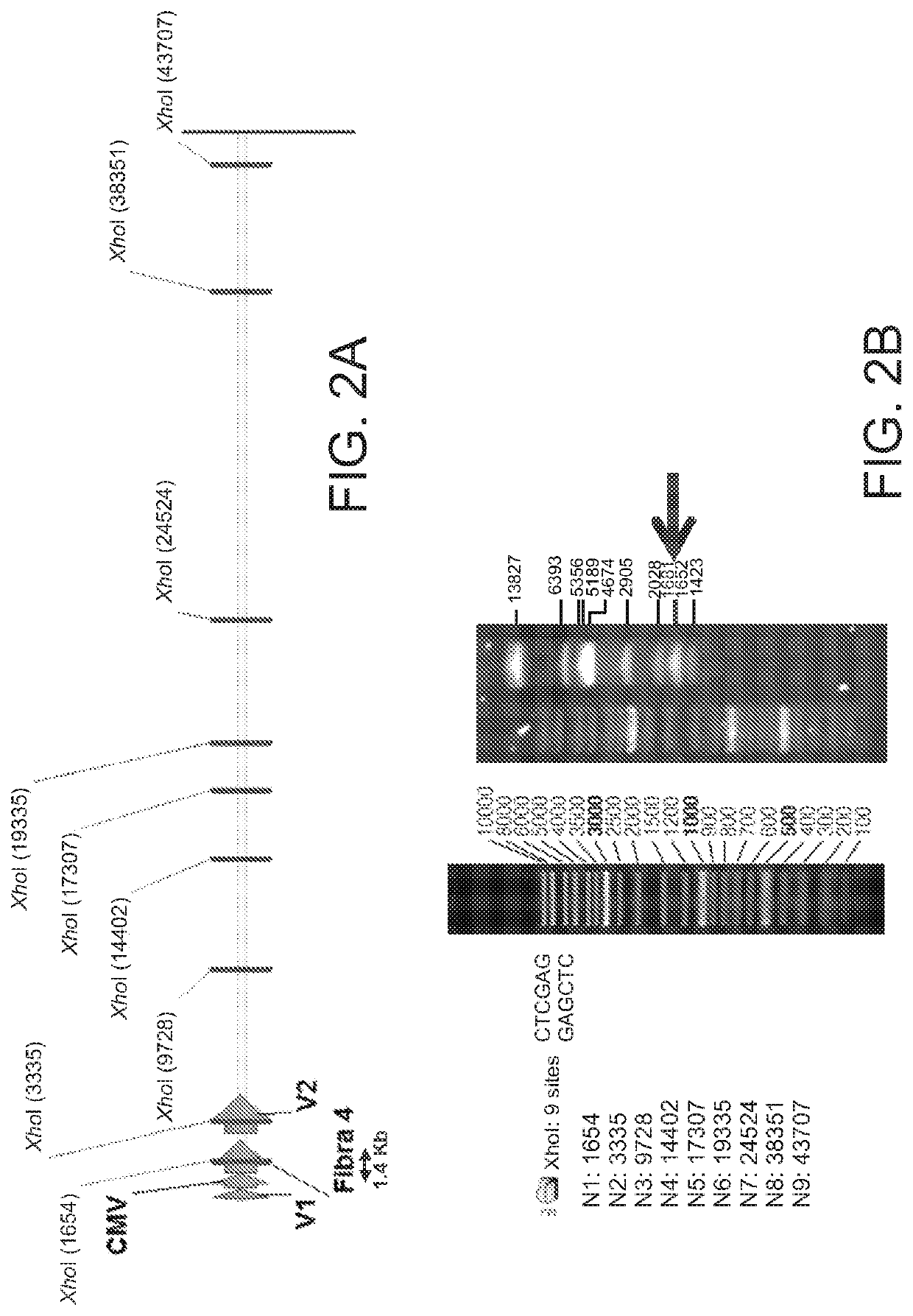Vaccine in the form of a recombinant sero type 9 avian adenovirus vector
a technology of adenovirus and recombinant vector, which is applied in the field of vaccines based on viral vectors, can solve the problems of general inhibition of the possibility of successfully utilizing adenoviruses at a commercial level, inability to generalize on the biological behavior of various known adenoviruses when being converted into a recombinant viral vector, and inability to show whether or not the viral vectors as built would be stabl
- Summary
- Abstract
- Description
- Claims
- Application Information
AI Technical Summary
Benefits of technology
Problems solved by technology
Method used
Image
Examples
example 1
n of an FAdV-9 Vector
[0091]Firstly, a FAdV-9 45 kb genome comprising SEQ ID NO: 1, generated by reverse genetics and containing regions FV1 (comprised between the 1-491 nucleotides) and FV2 (comprised between the 2,782-7,453 nucleotides), had its non-essential region of 2,291 pb removed, comprised between the 491-2,782 nucleotides, i.e., at the 5′ end of the genome; Further, a Swal site, unique for the genes of interest, was inserted at the 491 site. This genome was sub-cloned in the pBg plasmide to acquire the unique restriction sites at its ends to allow the generation of the alive virus in a culture.
[0092]Further, an EcoRV site was introduced in FV-2 using an oligonucleotide by the PCR technique, thus obtaining the intermediate pΔL2.4. In this intermediate, an original genome fragment comprised between the 4,391 and 7,453, nucleotides was deleted, remaining a recombinant arm of 2,100 pb. Further, the fragment of PCR EcoRV-EcoRV was cloned shunted in pShuttle from AdEASY, excising...
example 2
n of an rFAdV9-435 Recombinant Virus rFAdV9-435 in Cell Culture
[0094]According to the methodology described in Example 1, an FAdV-9 infectious clone with insertion of the H5 gene from low pathogenicity avian influenza virus VIABP-H5N2, strain 435 (rFAdV9-435) was obtained, with GenBank accession number FJ864690, and which comprises the sequence SEQ ID NO: 2.
[0095]Firstly, in order to obtain the master seed (SM), the rFAdV9-435 was replicated in CeLi line cells grown with DMEM F12+Glutamax culture medium, in cell culture bottles (static system). After performing 7 blind passes on the same cell type, a titer on immune peroxidase tests of 106.0DICC 50% was reached. The harvest was centrifuged at 500 g for 20 minutes, and it was fractioned in 1.5 mL cryovials, which were kept in deep freezing at a temperature between −70° C. and −80° C.
[0096]Tests were made to the SM to exclude the presence of bacteria, avian mycoplasma, fungi and yeasts, as well as to prove that said MS was avian virus...
example 3
n of Other Recombinant Viruses
[0099]Following the same methodology described above, additional FAdV-9 recombinant viruses were obtained according to what is shown in Table 1:
[0100]
TABLE 1FAdV-9 recombinant viruses generated with different inserts.Name of theInsertrecombinant virusAvian influenza H7 H7N3rFAdV9-H7IAFiber of hepatitis with serotype-4rFAdV9-Fib HClinclusion bodiesAvian laryngotracheitis glycoprotein BrFAdV9-gBLT(gB)Newcastle's disease HNrFAdV9-HNInfectious bronchitis S1 and S2rFAdV9-S1S2BIAvian influenza H5 and H7rFAdV9-H5H7IAPorcine circovirus ORF2rFAdV9-ORF2PCV2Avian infectious anemia VP1 and VP2rFAdV9-VP2VP1CAVAvian laryngotracheitis glycoprotein DrFAdV9-gDLT(gD)Salmonella enterica flagellin CrFAdV9-FliC
[0101]These recombinant vectors were characterized by XhoI digestion. In FIG. 1A the DNA restriction map of the rFAdV9-H7IA recombinant vector is shown; the 4.7 kb band shows the restriction fragment where the heterologous gene is cloned. In FIG. 1B a 3629 bp can be o...
PUM
| Property | Measurement | Unit |
|---|---|---|
| diameter | aaaaa | aaaaa |
| temperature | aaaaa | aaaaa |
| temperature | aaaaa | aaaaa |
Abstract
Description
Claims
Application Information
 Login to View More
Login to View More - R&D
- Intellectual Property
- Life Sciences
- Materials
- Tech Scout
- Unparalleled Data Quality
- Higher Quality Content
- 60% Fewer Hallucinations
Browse by: Latest US Patents, China's latest patents, Technical Efficacy Thesaurus, Application Domain, Technology Topic, Popular Technical Reports.
© 2025 PatSnap. All rights reserved.Legal|Privacy policy|Modern Slavery Act Transparency Statement|Sitemap|About US| Contact US: help@patsnap.com



